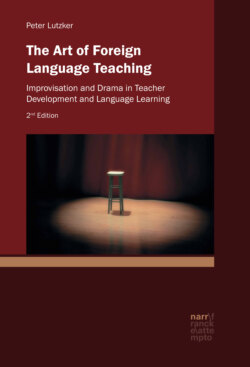Читать книгу The Art of Foreign Language Teaching - Peter Lutzker - Страница 70
На сайте Литреса книга снята с продажи.
6.4.2 The Solo-Improvisation
ОглавлениеThe next step is the solo improvisation. Each participant in turn leaves the room, puts together a costume from the large array of odd jackets, pants, skirts, shirts and hats which Gladwell has assembled in an adjoining room, puts on the red nose and comes back into the room, which has now taken on all the qualities of a stage with the rest of the group as the waiting audience.
In contrast to the great care he has shown in easing the participants into the work until this point, his decision to begin with a solo improvisation as opposed to beginning with less terrifying partner work seems at first somewhat inexplicable. In one of the interviews he explains the rationale behind this choice:
If you started by improvising with a partner, you could easily get the wrong idea about clowning improvisation because a partner would fill the emptiness. It is important for someone starting in this work to connect to what is at the core of clowning which is something around space, emptiness and presence. (…) If the focus of our interest is the emotional state, then being lost, not knowing what to do is interesting. Out of that experience comes the realization that you don’t have to do anything and that it’s more interesting to see you not knowing what to do, rather than you doing something. If you had a partner, you could easily bypass that process of confronting your emptiness. (Interview 5)
In these first improvisations Gladwell plays a very supportive role, often speaking to the actor, encouraging him or her to look at the audience, to breathe, to trust that what is happening is fine and to stay with that moment. Quite often it is his positive support at those moments that enables the participant to stay with those moments of being lost, of being afraid, and in the clown’s visibly living out those emotions on stage, something very humorous and often very poignant becomes visible to everyone. A space has been created in which a feeling of being completely uncertain and vulnerable becomes not only acceptable, but through the support and usually the laughter of Gladwell and the other participants this initial feeling becomes transformed. Quite often a story begins to unfold which gathers imaginative momentum and energy, surprising everyone, not least the clown himself:
The ability to hold and make safe a space that is quite frightening is an important aspect of teaching this work. I trust this space and hope that I can communicate this trust to others. My experience tells me that it is OK for a clown not to know what to do on stage and to be lost. But it won’t feel OK, if you’re on stage feeling terrified and thinking you have to do something. Of course, what I see is a terrified clown desperately trying to think what to do and I let you know that, so you might start playing at being terrified. But if you are just terrified and you can’t play at being terrified, it won’t feel OK for you, even if I reassure you that it is OK. The difference is subtle but tangible and you see it in the eyes, which is why eye contact is so important. Once someone’s focus is not on what has to happen, but on what is being lived, they start to enjoy those feelings. (Interview 5)
After a while Gladwell rings his little bell, which is the previously established signal that an improvisation should now slowly be coming to its end and the clown should seek an opportunity for an appropriate exit from the stage.
